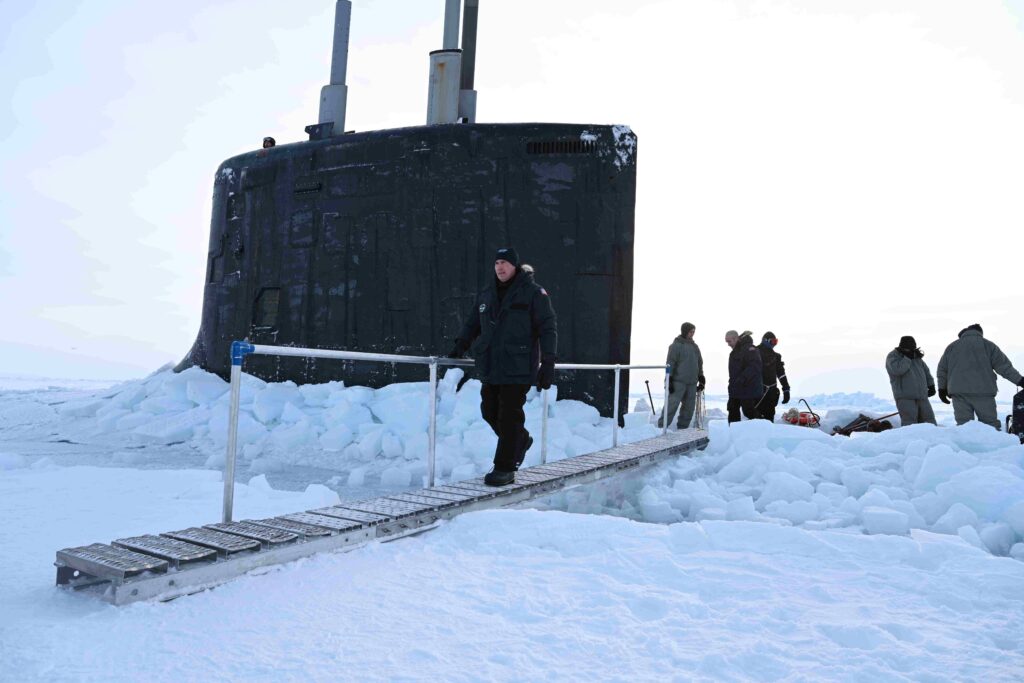
NATIONAL HARBOR, Md. — U.S. Navy and Coast Guard officials say maintaining a reliable presence in the Arctic, by ship, aircraft or submarine, is crucial to protecting American interests and sovereignty in the High North.
However, Coast Guard Vice Commandant Admiral Steven Poulin said maritime patrol planes and ice breakers aren’t enough to achieve his “top priority’’ of forward presence in the Arctic’s hostile environment.
Speaking on an Arctic strategy panel April 3, Poulin said consideration of the supply and repair needs of those systems and the care of the men and women who crew those systems requires investment in infrastructure to support forward basing. Both Poulin and another panel member, Vice Admiral William Houston, Commander of Naval Submarine Forces and the U.S. Atlantic Fleet, agreed there were three U.S. strategic objectives in the Arctic: sovereignty, safety, and security. They also agreed that to accomplish them U.S. Arctic maritime operations must extend beyond Alaskan waters.
Allies and partners that share values like freedom of navigation, environmental concerns and the rule of law are needed, especially since the United States has only two ice breakers and no deepwater ports or air bases bordering the Arctic Ocean. Kodiak, Alaska near the Bering Sea, is a thousand miles from Alaska’s Arctic coast.
Melting Arctic sea ice due to climate change has been opening new sea lanes, untapped fisheries, and previously unreachable petroleum, natural gas, and mineral deposits across the top of the world.
The Arctic is “an area of increasing human activity” and “increasing global competition, whether it’s for resources, access or presence. And so, for us, the key is good governance, a rules-based order that increases stability for the region. It’s also about protecting America’s sovereignty and sovereign rights,” Poulin said.
Russia has increased its military presence along its Arctic coast, reopening Cold War era bases and building several new ones. China, which styles itself a “near Arctic nation,” has made several scientific expeditions in the region and has conducted at least one naval exercise with Russia inside U.S. territorial waters.
Houston said Navy submarines have plied polar waters since 1947, and U.S. submarines, aircraft and other surface vessels have conducted 100 exercises like ICEX and Northern Edge with the United Kingdom, France, and Canada among other nations’ navies. U.S. submarines are now stopping in Tromso, Norway to pick up supplies and drop off and pick up crewmembers.
Both Poulin and Houston said communications at high latitudes was a challenge. The Navy is investing “a quarter of a billion dollars” in the Arctic where communications is absolutely key, said Houston. “If you cannot communicate, you can get yourself in a lot of trouble.” The Navy has no surface vessels with ice hardened hulls. The Coast Guard’s first polar security cutter, a heavy, armed ice breaker, is not expected to be available for years. Poulin said the Coast Guard was hoping for delivery in Fiscal 2026.
- Shall We Play a Game? Winning Isn’t the Point, Experts Say - April 5, 2023
- U.S. Goal: Maintaining Extended Presence in Arctic’s Harsh Environment - April 4, 2023
- Joint, Combined Exercise Shows Marine Littoral Regiment Idea is on ”Right Track’ - February 24, 2023






